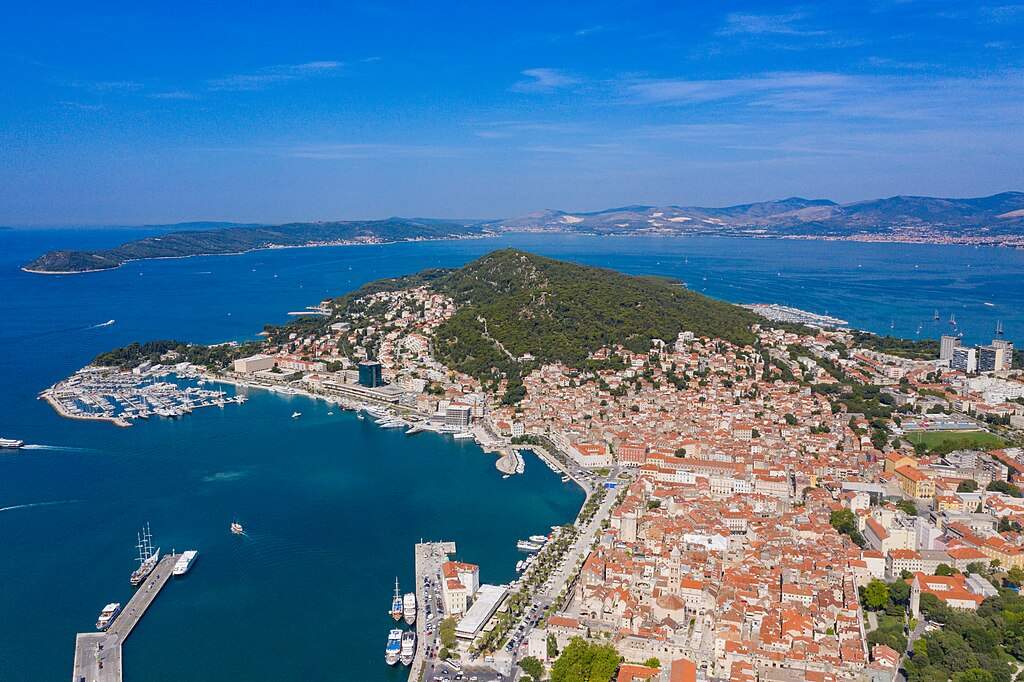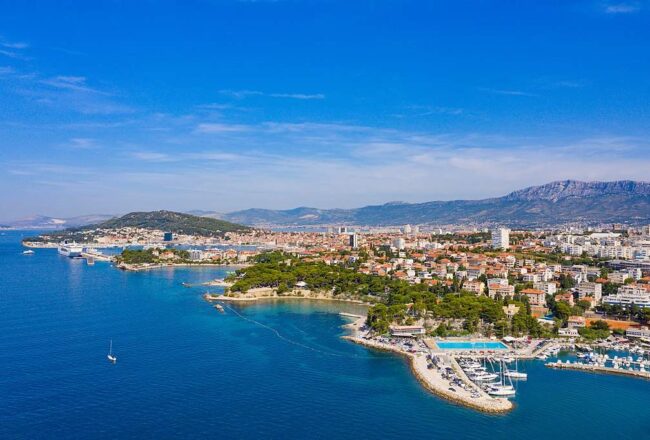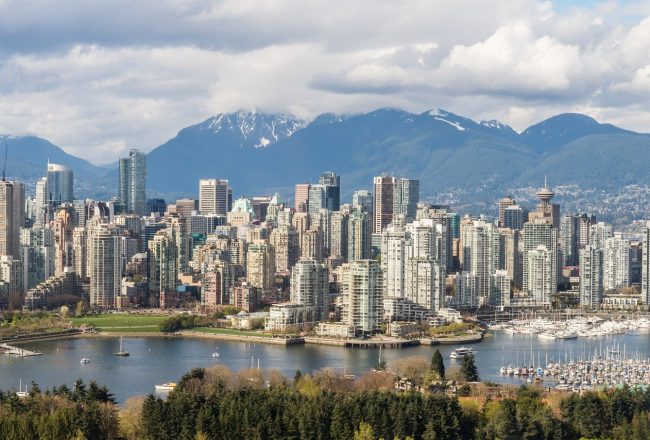Why Split Croatia belongs on your list
At its core is the UNESCO‑listed Historical Complex of Split with the Palace of Diocletian, a living architectural organism where homes, shops, and sacred spaces weave through Roman stone.
Outside those walls, the Riva opens to a long sweep of sea and sky, a social stage for coffee, conversation, and that late‑day glow that makes even a short walk feel like an event.
Perhaps the best part is how close everything sits: ferries for island day trips, piney paths on Marjan Hill, and small beaches where a quick swim can reset the day.
Split Croatia at a glance
Split is Croatia’s second‑largest city and the cultural centre of Dalmatia, with a compact historic core anchored by Diocletian’s Palace.
The palace and surrounding historical fabric were inscribed on the UNESCO World Heritage List in 1979, a recognition that underpins ongoing preservation and visitor management.
Travellers tend to stay two to four days, folding in the palace, the Riva, a hill walk or two, and a beach or island hop when the weather cooperates.
Map it in your mind: palace, Riva, Marjan
Think of the old town as the palace grid plus later medieval lanes, with four gates as useful wayfinders and the Peristyle as a natural centre of gravity.
The waterfront promenade (the Riva) runs along the south face of the palace, linking cafes, ferry views, and the easy rhythm of local life at virtually all hours.
Marjan Hill rises just west of the centre, threaded with steps, viewpoints, chapels, and shaded paths that feel surprisingly calm compared with the palace at noon.
Top things to do in Split Croatia
Walk the living Roman palace
Diocletian built his palace at the turn of the 4th century, and today the complex is the city’s living heart—half museum, half neighbourhood, entirely itself.
Wander the Peristyle, peek into courtyards, and notice how daily routines—shopping, worship, dinner—still fold into this ancient plan.
For background or to double‑check opening notes and cultural context, review the UNESCO World Heritage listing, which concisely frames what you’re walking through. UNESCO listing.
Climb the Cathedral of Saint Domnius bell tower
The former imperial mausoleum became the cathedral, and its slender bell tower offers broad views over the palace roofs, the harbour, and the hills beyond.
If heights and steps are on your mind, consider a late‑afternoon ascent when the light softens and temperatures ease, which often makes the experience gentler.
Unwind on the Riva
The Riva is Split’s social spine, where an unhurried coffee can take an hour and nobody seems to mind if it takes two.
Morning is calmer, evening is luminous, and between the two you’ll find that pleasant hum that makes even a short stroll feel like time well spent.
Walk or cycle Marjan Hill
Marjan’s steps and paths climb quickly to views that layer sea, city, and islands in one sweep, with pines offering shade and the chance to pause without agenda.
It’s close enough to the old town to fold into a single day, yet different enough in feel to reset the senses after the palace’s busier lanes.
Markets and everyday moments
The Green Market (Pazar) and the fish market show a different tempo of life, practical and proud, where the day still bends around fresh produce and the sea’s rhythms.
Go early for a sense of routine and mid‑morning for energy, then circle back to the Riva for coffee when the sun has warmed the stones.
Beaches close to the centre
City beaches such as Bačvice, Firule, and Kašjuni each have their own feel, from family‑friendly shallows to pebbly coves with clear water and a wilder backdrop.
If choosing feels tricky, a short, focused explainer can help you decide, and there’s a full breakdown in the beaches guide for tides of detail.
Split Croatia itineraries you can trust
With one day, sweep the palace and Peristyle, climb the bell tower, drift along the Riva, and finish with a Marjan viewpoint as the light tilts golden.
Two days let you add a museum or gallery and a slow beach morning, while three days invite either an island hop or the Klis–Salona loop for history and views.
If you prefer turn‑by‑turn sequencing, save the dedicated 1–3 day itinerary for when you’re ready to lock in your route.
Day trips from Split Croatia
Trogir’s UNESCO‑listed old town is an easy half‑day, with stone lanes and seaside edges that pair nicely with a long lunch and a wander.
Klis Fortress sits above the city with broad panoramas, and Salona’s Roman remains add depth to the palace story you’ve been walking.
For islands, fast boats reach Hvar, and ferries connect Split to Brač and other neighbours; schedules shift seasonally, so confirm times with the ferry operator.
Route pages are also handy when you want specifics—for example, Split–Hvar fast service or the Split–Supetar ferry for Brač—so you can plan departures that suit your day.
If you’d like a compact shortlist with transit pointers and first‑stop priorities, open the dedicated day trips guide and bookmark it for later.
Eating and drinking
Dalmatian cooking leans into the sea with simplicity—grilled fish, octopus salad, black risotto—and then rounds things out with slow braises and island wines.
Coffee culture anchors the day, and the Riva is the stage for it; it’s not about speed, it’s about presence, which might be the most useful planning note of all.
Practical logistics for Split Croatia
Arrivals are straightforward, with the ferry port beside the old town and the bus and rail links feeding directly into the centre, which keeps transfers short.
For island services, consult the operator’s sailing schedule and note that high‑season frequency and demand can make advance planning sensible, even if spontaneity is tempting.
Walking covers most of the historic area, and a gentle awareness of steps and cobbles makes the day easier, particularly if you’re eyeing hill paths later.
Where to stay
Inside or just outside the palace puts you in the middle of things, close to morning markets and evening passeggiata along the waterfront.
Areas edging toward Marjan are quieter and feel leafier, while staying near the ferry port makes early departures simpler if island days are the priority.
Responsible travel and etiquette
Respect the old stone: avoid climbing or leaning on delicate fabric of the palace, and keep voices soft in sacred or residential spaces.
Follow local guidance on waste, water, and protected areas, and check the official tourism board for current event notes and practical advisories.
A gentle way to plan
Begin with one anchor—perhaps a morning in the palace—and let the rest of the day form around coffee on the Riva and a hill walk before sunset.
If momentum gathers, add an island; if not, add another stroll, and call it a day well spent because sometimes the light and the mood decide for you.
Frequently asked questions
Is the palace truly part of everyday life? Yes, it’s a UNESCO‑listed “historical complex” precisely because the palace isn’t a sealed ruin—it’s a living urban space.
How many days do you need? Two to three full days cover the palace, Riva, Marjan, and a beach; add a day if you want an island or inland day trip without rushing.
Which island is easiest for a first hop? Brač via the Split–Supetar ferry is straightforward, while Hvar’s fast boats are quick if times align with your plan.
Where can you find official updates? The city’s tourism board maintains current event info and service notes that are useful during peak season.
Is there a best time for the bell tower? Late afternoon often brings softer light and cooler air, which makes the climb and the view feel kinder.
Keep exploring
When you’re ready to choose a swim spot, open the full beaches guide and let the map match your mood.
If sequencing helps, save the 1–3 day itinerary so mornings and evenings fall into place without fuss.
For a change of pace beyond the city, the day trips guide pulls the best inland and island options into one easy shortlist.






No Comment